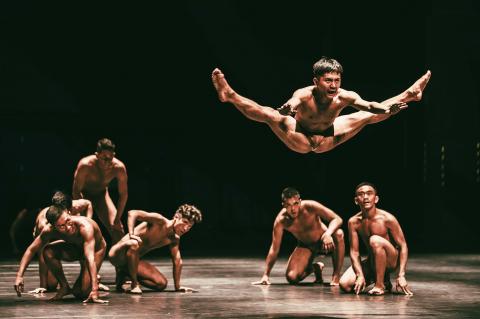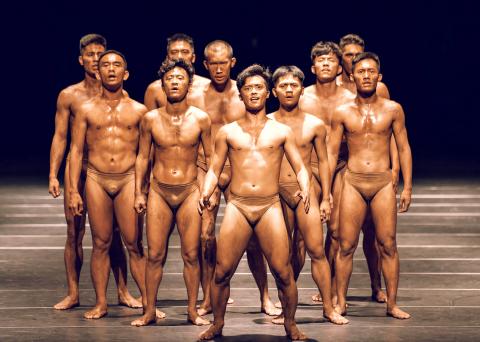Dance, like life, does not often provide second chances to make things right, but when it does, it can be very rewarding.
I left the Cloud Gate Theater in New Taipei City’s Tamsui District (淡水) on Friday night last week feeling exhilarated — like I could possibly dance all the way home. Great dance performances can have that effect on an audience, and a great performance was what I had seen.
It was, however, not what I had been expecting when I took the MRT out to Tamsui to see Bulareyaung Pagarlava’s (Bula) newest work for his Bulareyaung Dance Company (BDC, 布拉瑞揚舞團), LUNA (路吶).

Photo courtesy of Lafun Photography
I went to Taichung on May 19 to see the premiere of the show, which had been commissioned by the National Taichung Theater. A fan of Bula’s works since his early days as a resident choreographer for Cloud Gate 2 (雲門2), I have appreciated his efforts to forge a new creative identity by exploring his own Paiwan roots, as well as those of his dancers and other Aboriginal communities in Taiwan, with his works for BDC, such as 2015’s La Ke (拉歌), 2016’s Qaciljay (阿棲睞) and Colors (漂亮漂亮) as well as last year’s Stay that way (無,或就以沈醉為名).
I was underwhelmed by that first viewing of LUNA, for which Bula collaborated with the Luluna Bunun Choir (羅娜薪傳音樂團) from Luluna Village (羅娜) in Nantou County’s Sinyi Township (信義).
As I wrote previously: “There is a kernel of a great show there, but it needs to be polished and refined.”

Photo courtesy of Lafun Photography
Knowing that differences in the size and shape of the theaters in Taichung and Tamsui could affect the staging, and having heard that Bula had spent the time between the premiere and the Tamsui run doing some revisions, I decided a second viewing was needed.
He did make some changes, both to the choir’s performance that begins the show and in the choreography, but mostly it felt as if the overall energy of the work had been given a boost.
In Taichung, the men of the choir, armed with large staves, began pounding millet stones set in a circle at the front of the stage, while women and children could be seen dimly through a scrim, moving about a village-like setting as the men sang the Bunun’s pasibutbut, a polyphonic prayer for the millet harvest.
The scrim was then lifted, and then men returned as if from a hunt, sitting in a semi-circle while the women and several children stood behind, for the second song.
In Tamsui, the scrim was not used, the millet circle was moved to the back of the stage, next to the unshaded windows through which trees and the nighttime sky could be seen, and the children were allowed to run about naturally.
The acoustics of the Cloud Gate Theater also meant that the audience felt enveloped by the choir’s harmonies, as they were when the dancers began creeping through the darkness, clad in flesh-colored dance belt thongs, brown body make-up and headlamps, softly singing as they made their way down the aisles from the back of the theater, from the flyloft and from the sides of the stage.
Kung Bo-yuan Kwonduwa’s (孔柏元) strong vocals led the other 10 men in polyphonic song as they gathered on stage, although he disappeared soon after, returning only at the end to sing them off.
Bula used the metaphor of a nighttime hunt as an exploration of masculinity, how societal demands can shape — or crush — males and how the bonds between warriors are forged.
He has honed ability to use the dispassionate eye of an anthropologist even as he creates powerful images that rip through the masks that humans wear to shield themselves.
Watching LUNA is like getting a first-hand look at a warrior boot camp, and Bula certainly puts his troops — Ponay Ngangiwan, Kevan Tjuljapalas, Hsu Ting-wei (許庭瑋), Huang Wei-jie (黃韋捷), Cho Yu-rei (周堉睿), Siyang Sawawan, Aulu Tjibulangan, Chu Yu-hang (朱宇航), Kung Ya-ming (孔亞明) and Vaiarii Gaudin — through a hard series of drills, beginning with toddler-like butt crawls to clumsy walking through to stunning solos, pair work and group work.
Among the highlights were two sections where Aulu had the chance to show off his physical prowess.
First was a segment in which he moves through a series of poses as two other men first support him, then constrict him and finally crush him to the floor with their own bodies as he struggles, until the all that can be heard are his strangled rasps.
Then near the end of the show he performs a series of 25 high-flying leaps, legs spread completely perpendicular. Knowing that the sequence was coming up, I was ready to keep count. It is the male equivalent of a ballerina’s 32 fouettes in Swan Lake.
Keven, Hsu, Ponay and Huang also had some memorable moments, but really, it is the group dynamics that make the show. The 10 end united as fierce warriors — physically, vocally and emotionally.
It could have been an extra three weeks of hard work that made the difference between the premiere and last Friday’s shows. Or perhaps the troupe was inspired by the announcement on June 2 that Bula and BDC won the 16th Taishin Arts Award’ Performing Arts Award for last year’s Stay that way, which featured singers Muagai, Senayan and Ivi.
Whatever it was, it worked. LUNA is a great show.

“Why does Taiwan identity decline?”a group of researchers lead by University of Nevada political scientist Austin Wang (王宏恩) asked in a recent paper. After all, it is not difficult to explain the rise in Taiwanese identity after the early 1990s. But no model predicted its decline during the 2016-2018 period, they say. After testing various alternative explanations, Wang et al argue that the fall-off in Taiwanese identity during that period is related to voter hedging based on the performance of the Democratic Progressive Party (DPP). Since the DPP is perceived as the guardian of Taiwan identity, when it performs well,

The Taiwan People’s Party (TPP) on May 18 held a rally in Taichung to mark the anniversary of President William Lai’s (賴清德) inauguration on May 20. The title of the rally could be loosely translated to “May 18 recall fraudulent goods” (518退貨ㄌㄨㄚˋ!). Unlike in English, where the terms are the same, “recall” (退貨) in this context refers to product recalls due to damaged, defective or fraudulent merchandise, not the political recalls (罷免) currently dominating the headlines. I attended the rally to determine if the impression was correct that the TPP under party Chairman Huang Kuo-Chang (黃國昌) had little of a

At Computex 2025, Nvidia CEO Jensen Huang (黃仁勳) urged the government to subsidize AI. “All schools in Taiwan must integrate AI into their curricula,” he declared. A few months earlier, he said, “If I were a student today, I’d immediately start using tools like ChatGPT, Gemini Pro and Grok to learn, write and accelerate my thinking.” Huang sees the AI-bullet train leaving the station. And as one of its drivers, he’s worried about youth not getting on board — bad for their careers, and bad for his workforce. As a semiconductor supply-chain powerhouse and AI hub wannabe, Taiwan is seeing

Jade Mountain (玉山) — Taiwan’s highest peak — is the ultimate goal for those attempting a through-hike of the Mountains to Sea National Greenway (山海圳國家綠道), and that’s precisely where we’re headed in this final installment of a quartet of articles covering the Greenway. Picking up the trail at the Tsou tribal villages of Dabang and Tefuye, it’s worth stocking up on provisions before setting off, since — aside from the scant offerings available on the mountain’s Dongpu Lodge (東埔山莊) and Paiyun Lodge’s (排雲山莊) meal service — there’s nowhere to get food from here on out. TEFUYE HISTORIC TRAIL The journey recommences with